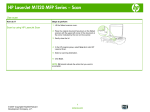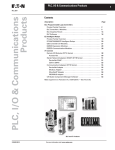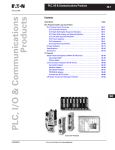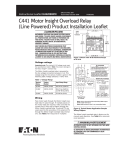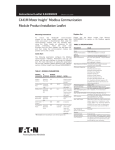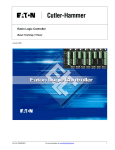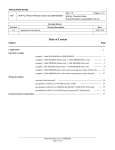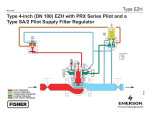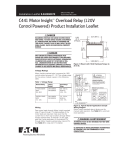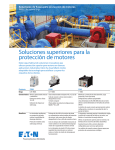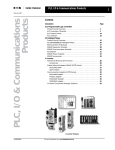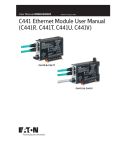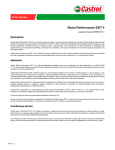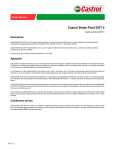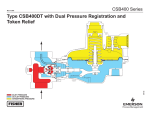Download How to Control and Monitor a Motor Insight Overload Relay With an
Transcript
Application Data AP04209001E Effective December 2008 How to Control and Monitor a Motor Insight Overload Relay With an ELC Logic Controller via Modbus Serial Application Overview The purpose of this application paper is to demonstrate how to control and monitor a Motor Insight motor protection relay operating in conjunction with a Freedom Series Contactor over Modbus serial. Motor Insight includes a relay that works in series with customer field wiring capable of energizing and de-energizing the contactor coil. Motor Insight provides a high level of protection for the motor and will not enable the contactor to be closed if any condition exists that could damage the motor. It will also open an energized contactor should such a condition occur while the motor is running. Motor Insight is a motor protection relay that can be used with any contactor. For this example, it will be used with Eaton’s Freedom Series contactor. This application note will show how to wire a Motor Insight with a Freedom Series contactor to a motor and will also show how to connect an ELC controller to a Motor Insight for control and monitoring over Modbus. There are numerous data parameters that may be monitored from Motor Insight, including: individual phase currents, average of three phase currents, individual phase voltages, average of three phase voltages, motor power, voltage unbalance, current unbalance, power factor, ground fault current, frequency, thermal capacity and a fault queue. This application example monitors all of these data parameters with the ELC controller over Modbus. This application example uses an ELC (Eaton Logic Controller) to control and monitor Motor Insight over Modbus serial, provided the customer supplied field wiring is satisfied. The customer supplied field wiring could be any contact interlock that will remain open when a system requirement to run the motor is not met. Any Modbus serial master may be used for controlling/monitoring Motor Insight. Full control of Motor Insight is accomplished via Modbus serial from the ELC controller and the customer supplied field wiring. An ELC message program is included with this application example. This ladder logic program effectively sends a Read message followed by a Write message continuously. If a fault occurs, the program will be notified immediately. The program writes either a Reset command to Motor Insight to close the contact or a Trip command to open the contact. Note: The Reset command will instruct Motor Insight to deenergize its internal relay, which in turn energizes the contactor provided the customer supplied field wiring is satisfied (see Figure 1). Sixteen different parameters are being continuously monitored from Motor Insight. How to Control and Monitor a Motor Insight Overload Relay With an ELC Logic Controller via Modbus Serial Application Data AP04209001E Effective December 2008 Motor Insight Power Wiring Diagram MI C T1 L1 T2 C Motor L2 T3 C L3 L1 L2 L3 L1 L2 & & & H O A NC X M Start Stop 95 X 2 96 3 M Customer Supplied Wiring Figure 1. Power Diagram with Customer Field Wiring Between Terminals 2 and 3 Note: When a Reset command is issued to Motor Insight, it will be enabled to close the contactor, provided the customer supplied field wiring is satisfied. Part Numbers Used for this Application Example (1) C441BA 2 – 9 A; 200 – 240 Vac (50/60 Hz) Motor Insight Table 1. Values Modbus Register Number Modbus Data Address Value Description 400 399 0x00DD Command Register: Relay OFF 399 0x00AA Command Register: Reset/Energize Relay (1) C441M Modbus interface module for Motor Insight 400 (1) CN15DN3 Freedom Series Contactor 300 299 n/a Phase A rms Current (1) ELC-PC12NNDR ELC Controller (Modbus master — Port 2) 301 300 n/a Phase B rms Current (1) ELC-PS01 ELC power supply 302 301 n/a Phase C rms Current Shielded cable for RS-485 Modbus connections between Motor Insight and the ELC controller. 303 302 n/a Average rms Current 304 303 n/a Phase A rms Voltage (L1-L2) Serial Modbus Connections from ELC Controller to Motor Insight 305 304 n/a Phase B rms Voltage (L1-L2) 306 305 n/a Phase C rms Voltage (L1-L2) 307 306 n/a Average rms Voltage 308 307 n/a Motor Power (kW) Scaling x100 309 308 n/a Voltage Unbalance % 310 309 n/a Current Unbalance % 311 310 n/a Power Factor 312 311 n/a Ground Fault Current 313 312 n/a Frequency 314 313 n/a Motor Thermal Capacity 315 314 n/a Fault Queue 1 ELC-PC12NNDR Motor Insight Modbus Port 2 connections Modbus module connections pin 1 Common + terminal ----------------------------------------- pin 2 Data + - terminal ------------------------------------------ pin 4 Data - Serial Modbus Addresses in Motor Insight for Control and Monitoring The Modbus Register address – 1 = Modbus Data Address. The Modbus Control Register in Motor Insight is 400 decimal and the Modbus Data Address for Control is therefore 399 decimal. The address used is determined by the Modbus master. The ELC Message Instructions use the Modbus Data Addresses to control and monitor Motor Insight. The values for energizing and de-energizing a contactor controlled by Motor Insight are as follows in Table 1. 2 EATON CORPORATION www.eaton.com Note: There are many additional parameters that can be monitored from Motor Insight. Motor Insight may also be configured via serial Modbus commands. Please refer to Chapter 8 Modbus Communications in the Motor Insight User Manual, Publication MN04209001E. How to Control and Monitor a Motor Insight Overload Relay With an ELC Logic Controller via Modbus Serial Application Data AP04209001E Effective December 2008 The ELC message program included with this Application Note writes one register to Motor Insight for control and reads the 16 parameters listed in Table 1. 3. Bit M1143 determines ASCII mode verses RTU mode for the port. Set this bit for RTU mode and reset it for ASCII mode. RTU mode must be used with Motor Insight. Configuring Motor Insight for Modbus Communications 4. These settings must then be locked by setting bit M1120. Please refer to the Motor Insight module’s User Manual, Publication MN04209001E, for information on configuring Motor Insight for the motor it will be protecting and other features. For this example, the ELC controller’s Modbus port is configured for the following interface parameters: Note: All interface parameters, except the Station Number must be set the same for all devices to properly communicate with each other. Each device must have a unique Station Number. An example of the RS-485 Protocol Screen is shown below. 19.2K baud, 8 bits/byte, 1 stop bit, even parity, RTU mode Motor Insight Modbus module must be configured with the exact same interface parameters, except the Modbus address. The ELC is node 1 and Motor Insight is node 2 on Modbus, for this example. The master on Modbus must support RTU mode. Motor Insight does not support ASCII mode. The Modbus interface parameters that need to be configured for Motor Insight are located under the Operation parameters on the unit. The Modbus Address is called the Device Address. The Baud Rate is located under the Advanced section, parameter P.00. 8 bits/ byte, even parity and 1 stop bit are the defaults and do not need to be changed for this example. If these three parameters need to be modified, they may be modified via P.01 on the keypad or via a Modbus command. Since Motor Insight only supports RTU mode, only 8 bits/byte are allowed. The parity and number of stop bits may be modified with a Modbus Write command (or P.01) to Modbus Register 442 (Modbus Data Address 441) as follows: Value of 0: Even Parity, 1 stop bit (default) RS-485 Protocol Screen Value of 1: Odd Parity, 1 stop bit Value of 2: No Parity, 2 stop bits Motor Insight — Communication Loss Behavior By default, when a communication loss occurs, Motor Insight will hold last state and not indicate a fault. The Modbus master’s messages will time out indicating that communications is lost to the device. P.04 is the “Comm Loss Behavior” parameter. However, this feature must be enabled to be used. It cannot be enabled from the keypad, but only with a Modbus command. If it is not enabled, Motor Insight will Hold Last State on a communication loss. If it is enabled, there are two choices: The following logic can be used to configure the interface parameters for the ELC controller’s communication port 2: M1002 MOV H97 D1120 8 bits/byte, even parity, 1 stop bit, 19.2 Kbaud MOV K1 D1121 Station Number 1 SET M1143 RTU Mode SET M1120 Lock Com2 Settings First Scan Bit 1 = Fault on Comm Loss (Default) 2 = Hold Last State on a Comm Loss To enable this feature: Send a Modbus Write command with a value of 0x0088 to Motor Insight’s Modbus Register Number 400 (Modbus Data Address 399). This will enable Communication Loss behavior. The 0x0088 will enable Motor Insight, by default, to report a fault and trip the contactor should a loss of communications occur. The other choice is Hold Last State on a Communication Loss. Setting up the ELC Controller’s Communication Port Figure 2. Logic Diagram This same process can be used to configure the RS-232 communication port 1. Use D1036 instead of D1120 for the baud rate, parity, stop bits and bits/byte. Select ASCII/RTU mode with bit M1139 and Lock the Com1 settings with bit M1138. This is included in the sample messaging program included with this application example. The communication port for RS-485 communications is Port 2. It is recommended to add logic to the program to configure the port at first scan. To accomplish this, add the following to the control program (this is included in the program supplied with this application example): 1. Under the Help pull down menu, select “Auxiliary Editing(C)”, then “RS-485 Protocol Setting.” Select the interface parameters, i.e., Baud Rate, Parity, Bits/Byte and Stop Bits. Then note the hexadecimal value for your choices. For example, 8 bits/byte, Even parity, 1 stop bit and 19.2K baud results in a hex value of 97. Add a MOV instruction to your program, to be executed at first scan to move H97 (representing 97 Hex) to register D1120. 2. Assign a station number. MOV K# to register D1121, where the # is the station number. EATON CORPORATION www.eaton.com 3 Application Data AP04209001E Effective December 2008 How to Control and Monitor a Motor Insight Overload Reference Number Serial Summary/Detailed Procedure If the Modbus master is an ELC controller, the following procedure should be straightforward. If another Modbus Master is used, be sure it is properly configured and sends the same Modbus messages as the ELC controller in this example. The steps to getting this application example working are as follows: 1. Configure Motor Insight’s interface parameters, per this application example. 2. Make the RS-485 connections between the ELC controller and Motor Insight’s Modbus module. 3. Load the ELC program supplied with this application example to the ELC controller using ELCSoft. Table 2. Supporting Documentation Documentation Reference Number Manual ELC System Manual MN05003003E Motor Insight User Manual MN04209001E Motor Insight Modbus Installation Leaflet IL04209002E Program Files ELC Message Program Motor_Insight.epc In the event additional help is needed, please contact the Technical Resource Center at 1-877-ETN-CARE. 4. Put the ELC controller into the Run Mode. 5. Go online with the ELC controller to view the program execution. 6. Right click on the M20 contact and “Set On” the bit to Reset Motor Insight and close the 95/96 Fault Relay contact. 7. Right click on the M21 contact in the program and “Set On” the bit to Trip/Stop Motor Insight and open the 95/96 Fault Relay contact. 8. View data addresses D500 through D515 to view the 16 data parameters being monitored with this ELC program. Eaton Corporation Electrical Group 1000 Cherrington Parkway Moon Township, PA 15108 United States 877-ETN-CARE (877-386-2273) Eaton.com © 2008 Eaton Corporation All Rights Reserved Printed in USA Publication No. AP04209001E / Z7931 December 2008 PowerChain Management is a registered trademark of Eaton Corporation. All other trademarks are property of their respective owners.





